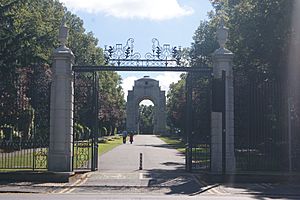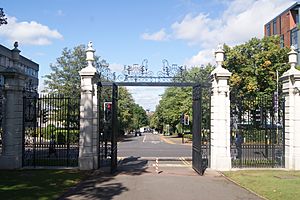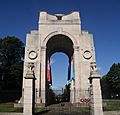Arch of Remembrance facts for kids
Quick facts for kids The Arch of Remembrance |
|
|---|---|
| United Kingdom | |
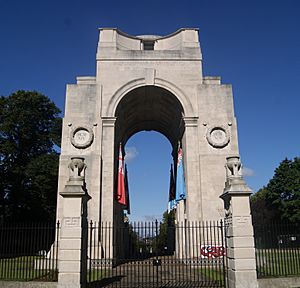 |
|
| For servicemen from Leicester killed in the First World War | |
| Unveiled | 4 July 1925 |
| Location | 52°37′24″N 1°07′17″W / 52.6234°N 1.1215°W Victoria Park, Leicester, England
|
| Designed by | Sir Edwin Lutyens |
|
Listed Building – Grade I
|
|
| Official name | The Arch of Remembrance |
| Designated | 23 February 1955 |
| Reference no. | 1074786 |
The Arch of Remembrance is a special memorial in Victoria Park, Leicester, England. It was designed by a famous architect named Sir Edwin Lutyens. This arch remembers the brave soldiers from Leicester who lost their lives in the First World War.
Leicester played a big part in the war. Its factories made many things needed for the war effort. After the war, people wanted a lasting way to remember those who served. A temporary memorial was put up in 1917. Then, in 1919, a group was formed to plan a permanent one. They chose Sir Edwin Lutyens to design it and decided to build it in Victoria Park.
Lutyens first suggested a very grand design, but it was too expensive. So, the committee asked him to design a memorial arch instead. He showed his new idea to the public in 1923.
The memorial is a tall arch made of Portland stone. It has four legs, making four openings. Two are large, about 36 feet (11 meters) tall, and two are smaller, about 24 feet (7.3 meters) tall. At the very top, there's a big dome. The main arches are lined up so the sun shines right through them on 11 November, which is Armistice Day. Inside, you can see painted stone flags representing the different British armed forces and the Merchant Navy.
This memorial is one of Lutyens's biggest and most impressive war memorials. It stands out in Victoria Park and can be seen from far away. It was officially opened on 4 July 1925 by two local widows. Many people, including Lutyens, were there. The arch cost £27,000 to build. Today, it is a Grade I listed building, which means it's a very important historic structure. Since 2015, it has been part of a national collection of Lutyens's war memorials.
Contents
Why Was the Arch Built?
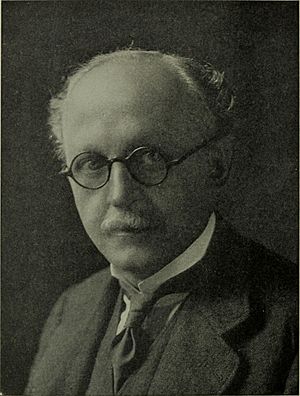
After the First World War, many thousands of people had died. Across Britain, communities wanted to build memorials to remember them. Sir Edwin Lutyens was a leading architect of his time. He became very well known for designing memorials. His most famous work is The Cenotaph in London, which is Britain's national war memorial. He also designed memorials for the Imperial War Graves Commission. This made him a popular choice for war memorial projects.
Victoria Park is a large open area in Leicester. It used to be a racetrack but became a public park in the late 1800s. When the First World War began, many soldiers from Leicester joined the army. Leicester's factories were very important for the war effort. They made textiles, footwear, and later, even howitzer shells. The city held rallies to encourage people to join the army.
In 1919, King George V gave Leicester city status. This was to thank the city for its help during the war. The King and Queen Mary visited Leicester that summer. They saw a parade of soldiers and veterans in Victoria Park. Thousands of people watched, including disabled veterans, nurses, and war widows.
How the Arch Was Planned
In 1917, a temporary war memorial was put up outside Leicester Town Hall. After the war ended in 1918, a public meeting was held in Leicester in May 1919. This led to the creation of a War Memorial Committee. This group was tasked with finding a good permanent memorial.
The committee decided to hire Sir Edwin Lutyens as the architect. They also chose Victoria Park as the best place for the memorial. Lutyens visited the site in October 1919. His first idea was a very large design, like a "tree cathedral" with a cenotaph (similar to the one in London). This plan would have cost a lot of money, around £23,000. However, by 1922, they had not raised enough funds. So, the committee decided to change the plan.
Two days later, the committee asked Lutyens to design a memorial arch. Lutyens said an arch would cost about £25,000. He suggested cheaper options, but the committee still wanted the arch. They showed the new design to the public in May 1923. Lutyens explained that the arch showed the city's spirit of triumph. He named it the "Arch of Remembrance." This name was chosen to avoid it sounding like a "triumphal arch," which they felt didn't fit the mood of sadness for the dead.
The new arch design was approved. Construction began in 1923 and finished by 1925. Because they still needed more money, the committee had to take out a bank loan. Some committee members personally promised to pay it back if needed.
What Does the Arch Look Like?
The Arch of Remembrance is made of Portland stone. It has a square shape with four strong legs, like a tetrapylon. It stands about 69 feet (21 meters) tall. There are two large arched openings on the main sides and two smaller ones on the other sides. The large arches are 18 feet (5.5 meters) wide and 36 feet (11 meters) tall. The smaller arches are 12 feet (3.7 meters) wide and 24 feet (7.3 meters) tall.
Stone wreaths are carved into the legs of the largest arch. Inside these wreaths, you can see the dates of the First World War: "MCM XIV" (1914) and "MCM XIX" (1919). At the very top of the arch is a dome. The city's coat of arms is carved on the back of the dome.
The main arches have a special coffered ceiling inside. The arch is built so that the sun shines directly through the main arches at sunrise on Armistice Day, November 11th. Inside the archway, there are four painted stone flags. These represent the Union Flag (for the British Army), the flag of the Royal Navy (the White Ensign), the flag of the Merchant Navy (the Red Ensign), and the Royal Air Force flag (the Royal Air Force Ensign). Lutyens often used painted stone flags in his memorial designs.
Above the front arch, you can read the words: "GLORY TO GOD IN THE HIGHEST AND ON EARTH PEACE." On the opposite side, facing the park, it says: "ALL THEY HOPED FOR, ALL THEY HAD, THEY GAVE TO SAVE MANKIND – THEMSELVES THEY SCORNED TO SAVE." These words are from a hymn called "O Valiant Hearts." Later, dates for the Second World War were added: "MCM XXXIX" (1939) and "MCM XLV" (1945).
The side arches also have important messages. The left arch says: "REMEMBER IN GRATITUDE TWELVE THOUSAND MEN OF THIS CITY AND COUNTY WHO FOUGHT AND DIED FOR FREEDOM. REMEMBER ALL WHO SERVED AND STROVE AND THOSE WHO PATIENTLY ENDURED." The right arch has words from William Blake's poem "And did those feet in ancient time": "I WILL NOT CEASE FROM MENTAL FIGHT NOR SHALL MY SWORD SLEEP IN MY HAND TILL WE HAVE BUILT JERUSALEM IN ENGLAND'S GREEN AND PLEASANT LAND."
The memorial is surrounded by iron railings. There are stone pillars with gates opposite each arch. These gates are usually kept closed because the arch is not meant to be walked through. The pillars are decorated with patterns and topped with stone urns.
Arches are not a common type of war memorial, especially for the First World War. Leicester's Arch of Remembrance is one of only three such arches designed by Lutyens. The other two are the Thiepval Memorial in France and the India Gate in New Delhi, India. The India Gate looks very similar to Leicester's arch, but it is much taller.
The Arch's Location
The Arch of Remembrance is built on the highest point in Victoria Park. This means it stands out and can be seen from far away. When it was first built, the area around it was more open. So, you could see the arch from even greater distances. Over the years, new buildings, like those of the University of Leicester, have grown up around it. This means the view is now partly hidden.
The area around the arch was made even more special later on. Sir Jonathan North, a local leader, paid for two grand entrances to Victoria Park. These were designed by Lutyens to match the war memorial. One entrance has lodges and gates near Granville Road. The other has gates and pillars leading to University Road. These entrances create special paths that lead directly to the Arch of Remembrance. The 150-meter path from the memorial to the University Road gates is called the Peace Walk. It is lined with flowers and shrubs.
History of the Arch
The Arch was officially opened on 4 July 1925. About 30,000 people attended the ceremony. Sir Edwin Lutyens and local important people were there. Two local widows, Mrs. Elizabeth Butler and Mrs. Annie Glover, unveiled the arch. Mrs. Butler had lost four of her eight sons in the war. Mrs. Glover had lost three sons, two nephews, and two brothers-in-law. The Bishop of Peterborough dedicated the memorial to the 12,000 men from Leicester and Leicestershire who died in the First World War.
The total cost of the memorial was £27,000. Lutyens's fee was £1,635. At the time of the unveiling, only £16,000 had been raised. The committee still needed £5,500 by the end of 1925. The five committee members who had promised to pay it back had to use their own money. Even though it cost a lot, the committee decided to spend all the money on the monument itself. This made Leicester's arch Lutyens's largest war memorial in Britain.
A local newspaper, the Leicester Advertiser, praised the design. However, it strongly criticized the war memorial committee. The paper said it was a "disgrace" that it took so long to raise the money. It compared Leicester's struggle to raise funds with the nearby town of Loughborough. Loughborough had built a carillon as its war memorial and raised money more easily.
Every year, a ceremony is held at the memorial on Remembrance Sunday. In 2017, the Arch of Remembrance was twinned with the India Gate in New Delhi. This was to honor members of the Indian Labour Corps who served in the First World War. As part of this, India's high commissioner to Britain placed a wreath at the Arch of Remembrance. Britain's high commissioner to India placed one at the India Gate. In 2018, Leicester City Council used a drone to take photos of the arch. This allowed them to see parts of the memorial that are usually too high to view from the ground.
The arch was first given a Grade II* listed building status in 1955. This was upgraded to Grade I in 1996. Grade I is for buildings of "exceptional interest." This means it is one of the most important historic buildings in England. The gates and pillars leading to University Road are also listed as Grade II*. Victoria Park itself is listed as Grade II on the Register of Historic Parks and Gardens. Being listed means these structures are legally protected from being destroyed or changed without special permission. In 2015, the Arch of Remembrance was included in a national collection of Lutyens's war memorials. This was part of the events to mark 100 years since the First World War.
Images for kids
See Also
- List of war memorials by Edwin Lutyens
- List of public art in Leicester






